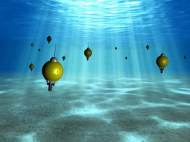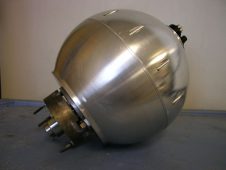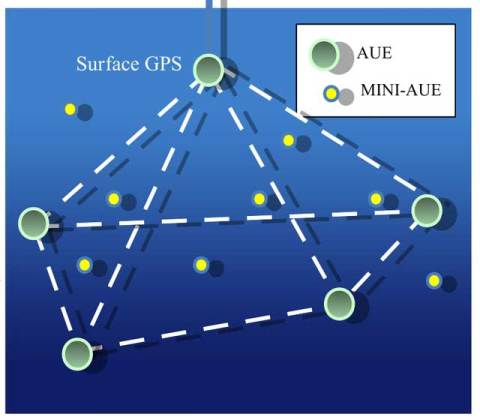Sensor networks of freely drifting Autonomous Underwater Explorers
 In an effort to plug gaps in knowledge about key ocean processes, the National Science Foundation (NSF)’s division of ocean sciences has awarded nearly $1 million to scientists at the Scripps Institution of Oceanography in La Jolla, California. The Scripps marine scientists will develop a new breed of ocean-probing instruments. Jules Jaffe and Peter Franks will lead an effort to design and deploy, or AUEs. AUEs will trace the fine details of oceanographic processes vital to tiny marine inhabitants.
In an effort to plug gaps in knowledge about key ocean processes, the National Science Foundation (NSF)’s division of ocean sciences has awarded nearly $1 million to scientists at the Scripps Institution of Oceanography in La Jolla, California. The Scripps marine scientists will develop a new breed of ocean-probing instruments. Jules Jaffe and Peter Franks will lead an effort to design and deploy, or AUEs. AUEs will trace the fine details of oceanographic processes vital to tiny marine inhabitants.
While oceanographers have been skilled in detailing large-scale ocean processes, a need has emerged to zero in on functions unfolding at smaller scales. By defining localized currents, temperature, salinity, pressure and biological properties, AUEs will offer new and valuable information about a range of ocean phenomena. Collectively, the entire “swarm” of AUEs will track ocean currents that organisms at a small-scale, such as tiny abalone larvae, for example, experience in the ocean.
“We’re seeing great success in the global use of ocean profiling floats to document large-scale circulation patterns and other physical and chemical attributes of the deep and open seas,” said Phillip Taylor of NSF’s division of ocean sciences. “These innovative AUEs will allow researchers to sample the environments of coastal regions as well, and to better understand how small organisms operate in the complex surroundings of the oceans.”
It is a system comprised of small drogues that are buoyancy controlled, acoustically tracked, equipped with sensors for data collection and are part of an adhoc network for relaying data to surface stations for analysis. The buoyancy control allows the drogues to collect data from various depths in the ocean. Propulsion is not needed as the drogues will be moving with the flow and obtaining data on circulation patterns. Eliminating the need for propulsion cuts down on energy cost which means we can have longer deployment periods. It also lessens the chance movable parts of probes could destroy the living environment.
Networking the drogues with acoustic modems gives a greater range for data collection. As long as the drogues are acoustically linked to each other, they can relay their data back to drogues which are closer to a fixed mooring. The fixed mooring can then send the data to a surface station. Without the network to relay data, all drogues would have to stay within range of the fixed mooring, or be recovered frequently for data download. Staying within the range of a fixed mooring would not give enough spatial resolution and frequent recovery would not be time or cost effective.
They used an acoustic tracking system to give the drogues needed location information, since the drogues will be at various depths underwater and GPS is not a viable tracking system for those conditions. The drogues will track the relative position of other drogues and send this information back to a surface station. On the surface, the data can be analyzed and absolute location can be extrapolated.
Various sensors can be put on the drogues depending on the system application. For instance, temperature and pressure sensors will be useful for almost any application. Flourometers will be useful for studies needing chlorophyll concentration data. Other possible sensors include dissolved oxygen, salinity, pH and turbidity sensors. The miniature robots will aid in obtaining information needed for developing marine protected areas, determining critical nursery habitats for fish and other animals, tracking harmful algae blooms, and monitoring oil spills.
For marine protected areas, AUEs will help inform debates about the best areas for habitat protection. With harmful algal blooms and oil spills, the instruments can be deployed directly into outbreak patches to gauge how they develop and change over time. In the case of an airplane crash over the ocean, AUEs should be able to track currents to determine where among the wreckage a black box may be located.
“AUEs will give us information to figure out how small organisms survive, how they move in the ocean, and the physical dynamics they experience as they get around,” said Franks. “AUEs should improve ocean models and allow us to do a better job of following ‘the weather and climate of the ocean,’ as well as help us understand things like carbon fluxes.”
Franks, who conducts research on marine phytoplankton, says that “planktons are somewhat like the balloons of the ocean floating around out there. With AUEs, we’re trying to figure out how the ocean works at scales that matter to plankton. If we place 100 AUEs in the ocean and let them go, we’ll be able to look at how they move to get a sense of the physics driving current flows.”
During the pilot phase of the project, Jaffe and colleagues will build five to six of the soccer-ball-sized explorers and 20 of the smaller versions. An outreach component of the project will enlist school children in building and ultimately deploying AUEs. Let’s hope some larger ocean organisms won’t eat the majority of sensors while they’re descanting and drifting thought water.











helpful